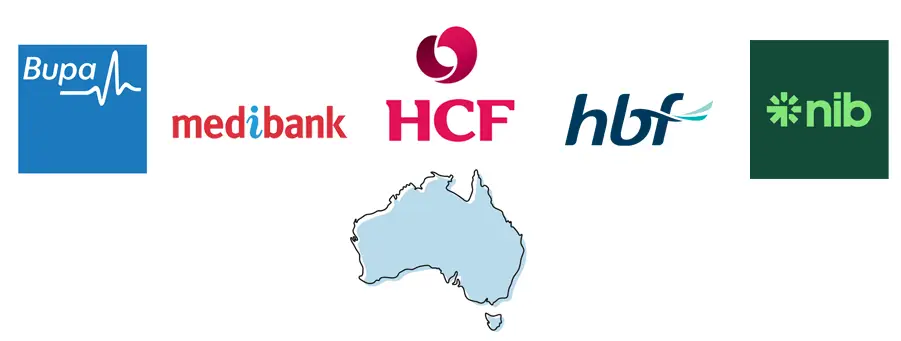It’s not entirely easy to find a comprehensive list of private health insurance companies available to Australians. From the largest health funds with the most members down to the small, local health funds with a tiny piece of the market pie, this article seeks to offer clarity and comprehensive information about the market share, membership availability, and business structure of Australian health insurers.
Let’s first take a look at who-is-who and how each health insurance provider operates in Australia. Market share, Membership and Structure is explained in greater detail below the table.
Top health insurance companies in Australia by market share
Data provided by the Private Health Insurance Ombudsman State of the Health Funds Report 2018. This report is the most recent available and is updated with data from the year prior on April 1st annually.
Market share
One of the most notable reveals of this list is that the memberships market share is incredibly top heavy. That is to say, most of the market share is dominated by few of the health insurers. Medibank and BUPA have a combined total market share of just under 54%. If we add HCF, NIB and HBF to the total, we can see that the top five health insurers in terms of size account for 80.2% of the entire market of insured Australians. We wrote an article suggesting that the size of a health fund does not necessarily mean it is higher performing.
This data is true for 2018 and will certainly have slightly changed since. We will update this table when the 2019 data is released in April 2020.
Membership
Although health insurance is non-discriminatory in Australia (pertaining to Community Rating as part of the Private Health Insurance Act 2007), a health insurer may not always be available to all citizens and residents who may wish to join. An Open health insurer means any Australian citizen or resident may join. An Open fund may offer different policies to residents of different Australian states or territories, or may not offer any policies at all in some states (see QCH – Queensland Country Health above has policies only available in Queensland and Northern Territory).
A Restricted health insurer means the health fund has limitations as to who may join. The restriction is most often limited by an occupational industry, the Defence services or Unions. Some examples are Defence Health memberships being restricted to people linked to service or employment in the Australian Army, Navy, Air Force or Department of Defence, or Teachers Health Fund memberships being restricted to people linked to specified teaching unions.
There are some very specific Restricted health funds such as ACA, who strictly provide health insurance products to employees of the Seventh-day Adventist Church (and their families). Another one is CBHS, or Commonwealth Bank Health Society – a health fund for current and former employees of specified CBA Group divisions (and their families). If you’d like to see if you are eligible for any Restricted health funds, contact us for advice and a quick answer on 1300 955 691.
Business structure
Not-for-profit health insurance funds are becoming increasingly recognized and rightfully so. Not-for-profit means the health fund is owned by its members and that all of the surplus profits go back into members after the costs to operate the fund have been subtracted. It’s interesting to note that four of the top six largest health insurers operate for profit.
The difference between for-profit and not-for-profit may not necessarily mean that one fund is better than another. However, data does suggest that the Members Own health funds pay overall higher benefits as a percentage of premiums paid by members. The Members Own health funds do not include all of the not-for-profit health insurers. It could be said that the for-profit health insurers could afford to pay more back to members if they were not-for-profit and that’s just common sense.

Portability
Don’t re-serve waiting periods when you switch to a new health fund or policy
“John was immediately covered for a hip replacement in private hospital because he had already served his waiting periods for joint replacements on his old policy”
List of current and former Australian health funds brand
There is a key difference between the terms health insurance provider and health insurance brand. A provider may operate or underwrite one or more health insurance brands. A great example of this is that NIB – Australia’s fourth largest health insurance company – provides, or at some point provided, the health insurance policies for white-label brands Qantas Assure, AAMI, APIA, Suncorp and TAL.
AHM (Australian Health Management) are a very popular health insurance brand who have began operating for nearly 40 years. They are in the top 10 health funds in terms of size and fairly well known and advertised. They were bought wholly by Medibank in 2009 at which point they became AHM by Medibank.
The following list includes some health fund brands that have been completely absorbed and have changed names entirely to the operator. For example, HBA and MBF members were a very long time ago changed to BUPA members, however, they may still be holding old HBA and MBF policies that have simply been re-branded.
This list may have been subject to change:






